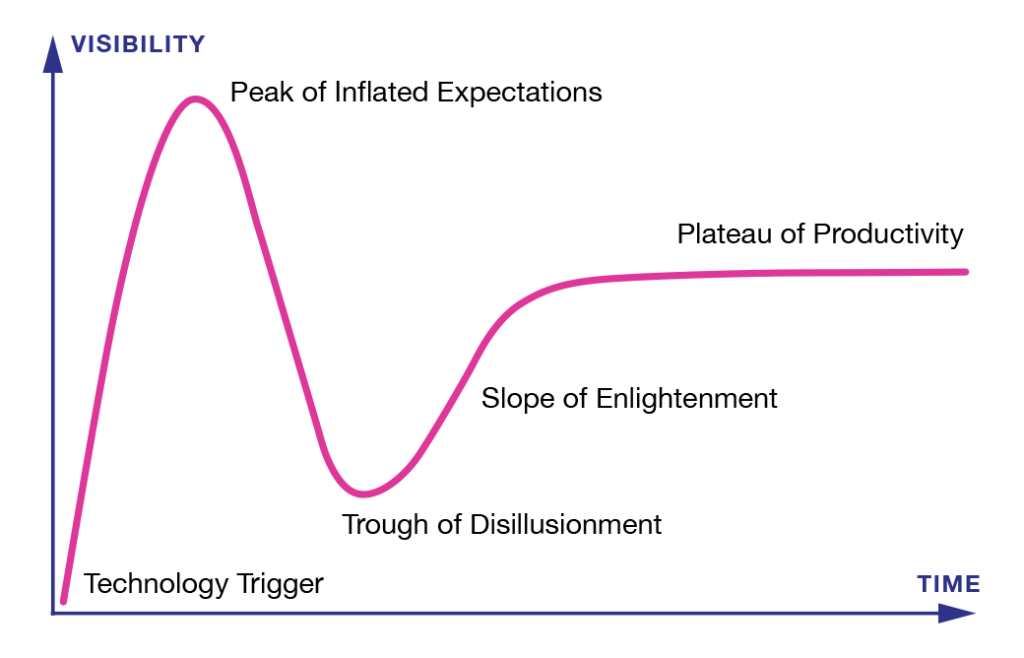A new swell in the AI sea has turned into a wave taking multiple industries by storm. In November 2022, the world first met the public beta launch of GPT-3 via the ChatGPT interface. Even those of us following the evolution of AI were expecting minor upgrades such as AI platforms like Jarvis, but we weren’t ready for the AI wave to rapidly evolve into a tsunami. What are the implications and impacts? We’ll get to that, but first: every new technology follows a wave pattern of evolution. Gartner puts it best with their Hype Curve, and it’s extremely relevant and important to understand as we consider the future of AI. Diagram 1 provides the key elements of the Hype Curve.

Every innovation follows a wave pattern. Some are small, a few are large, and a huge wave hits land every once in a while. The larger the wave, the larger the expectations — this article will clarify the size and pattern of the AI hype wave.
The Wave is Real
GPT-3 (and 4), Google Sparrow, and many other advanced AI models are launching in quick succession. There’s no doubt the wave is real and will make a lasting impact before the waters start to recede. However, the hype surrounding the topic isn’t currently aligned with the conversations within the market. What began as a quiet ChatGPT launch is now a regular feature on mainstream news outlets and in every tech blog. In fact, many of those blogs are bot authored. I’ve delved deep into the ChatGPT sea, and it does some incredible things. In my tests I have:
- Created bots which translate conversations while teaching languages
- Had bots help me build worlds and create scripts with realistic dialogue
- Generated articles in programmed voices which grade as 98% human
- Automated mass analysis of natural language (works great for reviews)
- Parsed and analyzed dozens of technical articles in seconds
- Made a presentation bot which outlines massive amounts of information into optimized presentations with a format I defined
- Choreographed dances
I live in this tool. I can’t imagine working without it anymore. That said, I’ve heard so many false narratives that trouble me and should concern you too.
Dispelling AI Myths
Remember the Blockchain wave from 2017? If companies aren’t careful, they may adopt a false narrative like so many did with Blockchain and never realize, let alone capitalize, on the power of AI tools. To help avoid this, I’ve outlined some AI myths that it’s time to dispel.
Myth #1: This technology should be used for automation of manual tasks.
Absolutely not. This technology isn’t about replacing people, and companies that try this will fail. The world is watching AI. The fact is no AI can replace a human at this time. AI today is a hyper-intelligent 10-year-old with a massive amount of knowledge and very little context. It will do what you tell it to but will fill in the blanks in often frustrating ways.
Human intellect in combination with AI is exponentially more powerful than either of these two components alone.
AI can augment human performance. For example, the night before an important presentation, I put together a set of highly detailed slides with little time or context. The tool was a lifesaver. I used it to read a few dozen websites, added my personal best practices and information about the client, and iterated for a couple of hours with this tool until I had a presentation with detailed explanations, industry statistics, robust citations, and a cohesive message. I couldn’t have done it without the AI, but it couldn’t have done it without me.
When you think of AI, you need to think of Iron Man, not Ultron. Human intellect is required, and collaboration with AI is exponentially more powerful than either of these two components alone.
Myth #2: We should be first to market utilizing these AI tools
Not a smart move. I remember seeing entirely non-digital businesses touting Blockchain in their names and seeing their valuations rise in 2017. It didn’t last. This pattern will happen again. Many tools will launch with the AI hype, but most won’t be worth your time. For example, there’s a process called Reverse Prompt Injection, which scrapes the underlying prompts in any tool. The vast majority of these services are highly simplistic and simply bundling functionality you can have for free behind a paywall. Be highly suspect of any technology touting AI as a key capability for a while, and absolutely don’t make it a central part of your business (yet). I’ve advised numerous clients not to believe experience platforms claiming to be AI-driven, as the underlying technology claims aren’t proven.
Myth #3: I’m not technical enough to use this tool
Wrong. Everyone can and should, and the digital marketing and customer experience optimization world MUST start to understand and use AI. This proliferation of AI is the greatest advancement since the Internet, and avoiding it would be like the seasoned sales teams of old refusing to use email because they liked their Rolodex. AI won’t replace people, but people using AI will absolutely replace the people who refuse to leverage it.
As far as technical difficulty goes, not only are AI tools, but ChatGPT specifically, easy to use, but they open up a technical-focused playground to practically anyone who’s interested. I wrote a comprehensive program in Java, from my phone, in bed, gating my time to one hour total, and it compiled and ran essentially as I requested. The cool part is that I don’t know Java – the AI walked me through the compiling process. I was impressed.
AI won’t replace people, but people using AI will absolutely replace the people who refuse to leverage it.
If you aren’t technical, but want to understand or debug some code, I built prompts that make it as easy as pasting the code, getting a detailed lesson about it, suggesting improvements, and providing translations to other languages.
I’m planning a lab for a high school on AI technology, and the students (14 and 15) are already designing a game (for fun) without any prior coding knowledge. They’re learning Java for fun while building a game with the power of AI.
Non-technical people can and should use these types of tools.
Myth #4: This is a threat to (seemingly any industry)
Yes and no. Yes, it’s a threat to companies and people who don’t learn, embrace, and integrate this technology for what it does well. It’s a threat to those who try to use it without human intellect. It isn’t a threat to those who adapt. For example, universities must change. They changed with the Internet and will need to do so with AI as well. It isn’t a threat to individuals, but an opportunity to expand learning and growth. ChatGPT taught me to samba dance and weld just two days ago. I’ve learned more in the last two months than in a very long time.
Navigating The AI Wave
Ride the AI wave, but make sure it doesn’t wipe you out. Be excited but intentional. Adopt it but don’t rely on it. Use it to grow. Don’t fear the possibility of it replacing you. I advise extreme caution to any CEOs or accountants currently sharpening their pencils to make cuts based on automating people out of jobs. This technology has the potential to usher in a new world, so let’s make sure it’s one in which we all want to live. Speaking as someone living in it now, I assure you it’s amazing. If you want to learn more about what I and BlastX have discovered with AI, contact us today.

